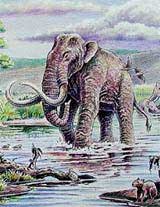Read mammoth DNA
 Scientists have assembled a piece of discrete gene fragments of mammoths, with 5,000 DNA characters that make up the complete mitochondrial genome of this extinct animal. This is a breakthrough in understanding the subspecies of the elephant family.
Scientists have assembled a piece of discrete gene fragments of mammoths, with 5,000 DNA characters that make up the complete mitochondrial genome of this extinct animal. This is a breakthrough in understanding the subspecies of the elephant family.
Research shows that mammoths are closest to Asian elephants, rather than African relatives. These three groups split from a common ancestor about 6 million years ago, and only about half a million years later, Asian elephants and mammoths "broke up" each other.
" We have finally unraveled the controversial creation of mammoths for nearly 10 years ," said Michael Hofreiter, lead researcher from the Max Planck Institute for Evolutionary Anthropology in Leipzig, Germany. .
Mammoths live in Africa, Europe, Asia and North America about 1.6 million years ago and became extinct about 10,000 years ago (at the beginning of the Fourth Century). The hairy mammoths, Mammuthus primigenius, with full-bodied fur cover have adapted to the extreme cold conditions of the ice age.
Previously, the DNA of several extinct mammals during that period (preserved in permafrost) was also analyzed, but not as detailed as in the mammoth study.
"This is the longest stretch of DNA decoded so far from specimens at the beginning of the Fourth Century, " Professor Hofreiter said.
About 46 DNA sequences were assembled and arranged in order, creating a complete map of mammoth's mitochondrial DNA - the kind of ring genetic material found outside the nucleus of the cell. This gene is inherited only in the maternal line, with small but frequent changes. Thanks to it, scientists can look at the past, and learn about the evolutionary relationship between different species.
Before the mammoth, there were moa birds - a flightless bird, extinct about 500 years ago - that were also completely decoded mitochondrial DNA.
Thuan An
- Study mammoth brain
- 42,000 year old mammoth exhibition
- The 700,000-year fossil suspected to be 'precious' mammoth
- Display of mammoth corpses intact
- Mammoth exhibition 39,000 years ago
- Revealing how extinct 'dodge' mammoths lived for 10,000 years
- Found mammoth ivory in the middle of American streets
- Discovering mammoth bones near Paris
- Display of 39,000-year-old mammoth corpses
- Detecting mammoth remains with soft tissues and feathers
- Find the remains of the mammoth intact
- Found a yard of mammoth bones in Serbia
 Discovered an ancient centipede fossil 99 million years old
Discovered an ancient centipede fossil 99 million years old Discovered bat-like dinosaurs in China
Discovered bat-like dinosaurs in China Discovered a 200-year-old bronze cannon of the coast
Discovered a 200-year-old bronze cannon of the coast Discover 305 million-year-old spider fossils
Discover 305 million-year-old spider fossils